Published in 2019, this is the opening volume of Wolfpack Publishing’s Avenging Angels series. My wife Barb and I had previously read the seventh and second installments out of order (long story!); and having really liked those, we recently decided to commit to reading the series. This one takes us to the very beginning of the titular “avenging angels'” adventures.
The Bass twins, George Washington (nicknamed “Reno”) and Sara, were 16 in the fall of 1865, just after the Civil War, when they returned home from school and found their western Kansas homestead burned and their parents and three older siblings dead or dying, murdered by a band of vengeful renegade ex-Confederates. (Their sister had also been gang raped.) Before he died, their father charged them to avenge that slaughter. This book is the story of that quest and its outcome (hence the title). “A. W. Hart” is a house pen name; all of the books of the series have different actual authors. Here, the writer was Peter Brandvold, who grew up as a Western fan in the 60s and 70s and went on to write over 100 Western novels, under his own name or his “Frank Leslie” pen name. (Neither Barb nor I had any prior experience with his work.)
There are a couple of significant continuity issues between this volume and the later ones, though these aren’t Brandvold’s fault. Starting in the second book, our hero’s and heroine’s promise to their father is said to have explicitly included a charge to continue to hunt down and rid the earth of other evil-doers, even after justice was served on the original villains. That’s not at all clear and explicit here. At the end of this book, their resolution to make their quest a continuing one is said to be their own decision, a response to an emotional need of their own. And in the seventh book (and possibly others earlier), the late John Bass is described as having been a Lutheran pastor. In this book, while he’s said to have been a God-fearing person who raised his kids to be familiar with the Bible, there’s no hint that he was a clergyman of any kind. IMO, on both points, the portrayal here is more plausible and realistic.
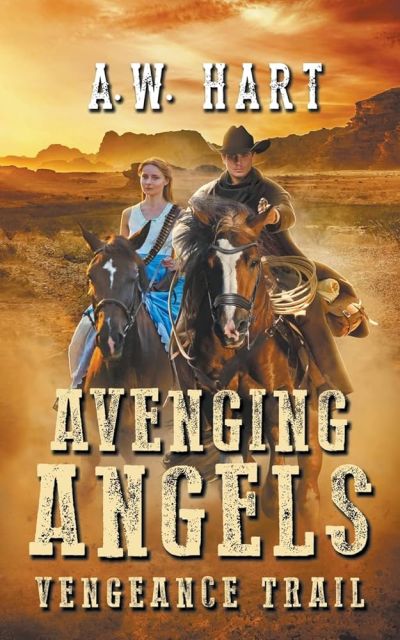 However, there are definite flaws in Brandvold’s craftsmanship here, starting with chronology. John Bass served in the Mexican War, after which he married and settled in Kansas. The Bass family graveyard on the homestead is said to hold the remains of an infant sibling who died over 20 years before 1865 –in other words, before 1845, and the Bass twins would have been born ca. 1849. But the Mexican War was fought from 1846-1848. There isn’t time between Feb. 1848 and the end of 1849 to fit in John Bass’ post-war activity, subsequent courtship and marriage, the couple’s move to Kansas, and four pregnancies prior to Reno and Sara. (And Kansas was not even opened for settlement until 1854.) If his general knowledge of U.S. history didn’t furnish red flags here, very basic research would have precluded these kinds of mistakes.
However, there are definite flaws in Brandvold’s craftsmanship here, starting with chronology. John Bass served in the Mexican War, after which he married and settled in Kansas. The Bass family graveyard on the homestead is said to hold the remains of an infant sibling who died over 20 years before 1865 –in other words, before 1845, and the Bass twins would have been born ca. 1849. But the Mexican War was fought from 1846-1848. There isn’t time between Feb. 1848 and the end of 1849 to fit in John Bass’ post-war activity, subsequent courtship and marriage, the couple’s move to Kansas, and four pregnancies prior to Reno and Sara. (And Kansas was not even opened for settlement until 1854.) If his general knowledge of U.S. history didn’t furnish red flags here, very basic research would have precluded these kinds of mistakes.
Editing and proofreading here is poor. Brandvold loses the thread of which character is speaking in one key conversation; he can’t make up his mind whether two or three antagonists are positioned in one spot during a gun fight, and near the end, a character’s last name unaccountably changes from Hill to Stock in the space of two pages. The third-person narrative is consistently from Reno’s viewpoint, but in the earlier chapters it incorporates gunslinger’s slang (thankfully abandoned later) that a peaceful teenage farm boy would be unlikely to be acquainted with. Near the end, conduct by two of the villains is inconsistent with their group’s overall plan. There are other logistical and editorial quibbles that could be made as well.
Both Sara and another important female character, Isabelle Mando, act out of character, or unrealistically for the situation, in one place (though not in the same place). Sara’s character, in particular, comes across as less winsome here than it does in the two later books we read. Of the two twins, she’s always been the more enduringly angry and vindictive over her family’s tragedy, the more aloof and self-contained, and the more ruthless and readily inured to violence. Here, though, she has a readiness to execute even disabled and helpless adversaries that alarms Reno, and at the same time a willingness to ignore a rape attempt on someone else as none of her business. (Thankfully for the victim, Reno didn’t share that indifference.) At one point, Reno was feeling a genuine concern for the state of Sara’s soul, and a resolution to try to influence her for the better. But later, he’s surprised and puzzled when Sara expresses a concern about her own spiritual state; and that theme is never developed any further, just forgotten and left hanging. Brandvold is undeniably a prolific writer; but he comes across to me as a careless and hasty one who sacrifices quality to quantity.
While the main characters here are Christians, and there’s a definite theme of good vs. evil, with the idea that God sides with the former and against the latter, none of the series writers are necessarily Christians themselves as far as I know. Bible verses serve as epigraph and postscript, and are quoted at times in the text; but there’s no real presentation of the gospel of grace and mercy, and not much wrestling with the Christian ethics of lethal force in a fallen world. Despite the teen protagonists, this is not really YA fiction either; it’s a very violent book, with a high body count. (It is, however, free of sexual content, beyond some references to scantily-clad chorus girls in a frontier music hall, and has very little bad language.) There’s a chaste romance which some readers will see as marred by an insta-love factor; but in the cultural context, I wasn’t bothered by the latter, and for me it’s a plus that it’s inter-racial. (Positive portrayal of half-Lakota characters and a black character do Brandvold credit.)
While I didn’t rate this book as highly as the two later ones, Barb and I still plan to continue with the series. It won’t disappoint genre fans who like a heavy dose of gun-fighting action.
Author: A. W. Hart.
Publisher: Wolfpack Publishing; available through Amazon, both for Kindle and as a print book.
A version of this review previously appeared on Goodreads.
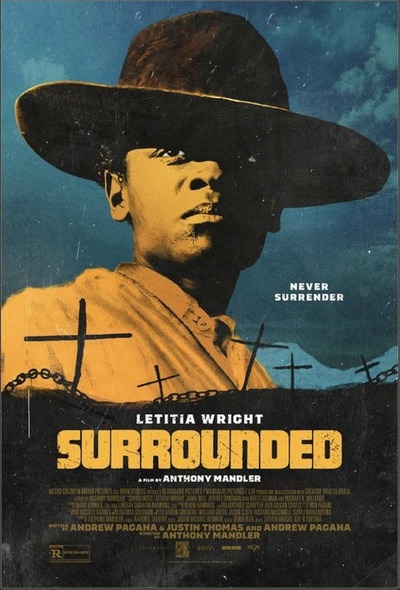 This is certainly a little different from the usual Western. It takes place a few years after the conclusion of the Civil War. Mo Washington (Wright) is on her way to Colorado to take up a piece of land she bought with her hard-earned savings. To avoid trouble on the journey, she is dressed as a man, though being black is problematic enough at that time. The stagecoach in which she’s travelling – or rather, on which, the driver not wanting a Negro inside – is attacked by brigands, led by notorious bank-robber Tommy Walsh (Bell). After a fierce fight, Walsh is captured, but the coach, complete with Mo’s documents, plunges off a cliff.
This is certainly a little different from the usual Western. It takes place a few years after the conclusion of the Civil War. Mo Washington (Wright) is on her way to Colorado to take up a piece of land she bought with her hard-earned savings. To avoid trouble on the journey, she is dressed as a man, though being black is problematic enough at that time. The stagecoach in which she’s travelling – or rather, on which, the driver not wanting a Negro inside – is attacked by brigands, led by notorious bank-robber Tommy Walsh (Bell). After a fierce fight, Walsh is captured, but the coach, complete with Mo’s documents, plunges off a cliff. 




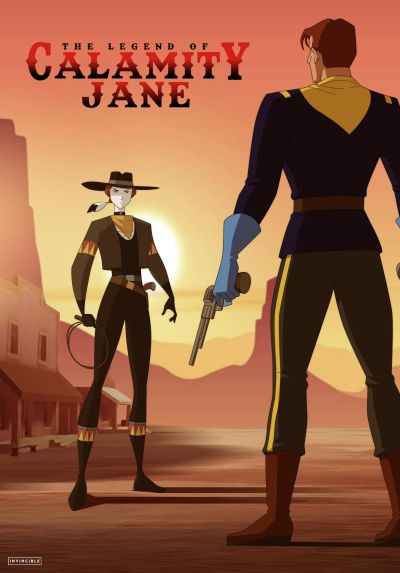 Martha Jane Cannary Burke, a.k.a. “Calamity Jane” (1852-1903) was a lot of things. But most of all she was the inventor of her own legend. By the end of the 19th century, dime novels based off her alleged adventures already sold very well. Unfortunately, the foul-mouthed and constantly drunk former frontier woman could never benefit financially from her reputation, with which others earned good money. She died early, though already perceived as a legend of the “old West”. To divide which of the many stories told about her are true, and which are not, is a job for the historians, not mine. For a character who definitely provided a “fill in the gaps” hero’s template, it’s no surprise Calamity Jane soon became a mythic legend of the “Wild West”, combined with other illustrious characters of that time such as “Wild Bill” Hickok, Wyatt Earp, Doc Holliday, Billy the Kid and many others.
Martha Jane Cannary Burke, a.k.a. “Calamity Jane” (1852-1903) was a lot of things. But most of all she was the inventor of her own legend. By the end of the 19th century, dime novels based off her alleged adventures already sold very well. Unfortunately, the foul-mouthed and constantly drunk former frontier woman could never benefit financially from her reputation, with which others earned good money. She died early, though already perceived as a legend of the “old West”. To divide which of the many stories told about her are true, and which are not, is a job for the historians, not mine. For a character who definitely provided a “fill in the gaps” hero’s template, it’s no surprise Calamity Jane soon became a mythic legend of the “Wild West”, combined with other illustrious characters of that time such as “Wild Bill” Hickok, Wyatt Earp, Doc Holliday, Billy the Kid and many others.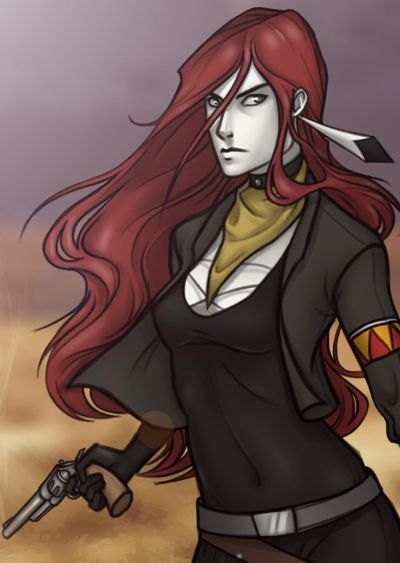 The show itself takes place around 1876 and is great fun. Calamity Jane is an adult, red-haired and green-eyed woman, with a whip that regularly comes in handy for dangerous situations. She is serious-minded and on the side of the law, meaning whenever help is needed, she will be there. She has a horse called Dakota and drinks milk (hey, what do you expect – it’s made for kids!). Always on her side is old Joe Presto (Welker) who can best be described as her comic sidekick, though sometimes comes across a bit simple-minded. Also, I sometimes had problems understanding his mumbling, though you get used to it. Of course, when you tell the story of Calamity Jane, Wild Bill Hickok is never far away. In real life she claimed that they were a couple in Deadwood. though according to historians, this could easily be another made-up story, as she was famous for doing. In this show, he helps her from time to time and is voiced by Clancy Brown (the Kurgan from Highlander).
The show itself takes place around 1876 and is great fun. Calamity Jane is an adult, red-haired and green-eyed woman, with a whip that regularly comes in handy for dangerous situations. She is serious-minded and on the side of the law, meaning whenever help is needed, she will be there. She has a horse called Dakota and drinks milk (hey, what do you expect – it’s made for kids!). Always on her side is old Joe Presto (Welker) who can best be described as her comic sidekick, though sometimes comes across a bit simple-minded. Also, I sometimes had problems understanding his mumbling, though you get used to it. Of course, when you tell the story of Calamity Jane, Wild Bill Hickok is never far away. In real life she claimed that they were a couple in Deadwood. though according to historians, this could easily be another made-up story, as she was famous for doing. In this show, he helps her from time to time and is voiced by Clancy Brown (the Kurgan from Highlander). Calamity Jane is one of the larger-than-life figures who populated the Wild West in its later days, as it was gradually becoming civilized. The truth about who she was is hard to determine, with verifiable facts hard to come by. But like Robin Hood, this just makes her raw clay, to be moulded into whatever shape writers and film-makers want. In Jane’s case this means her over the decades being played by anyone from
Calamity Jane is one of the larger-than-life figures who populated the Wild West in its later days, as it was gradually becoming civilized. The truth about who she was is hard to determine, with verifiable facts hard to come by. But like Robin Hood, this just makes her raw clay, to be moulded into whatever shape writers and film-makers want. In Jane’s case this means her over the decades being played by anyone from 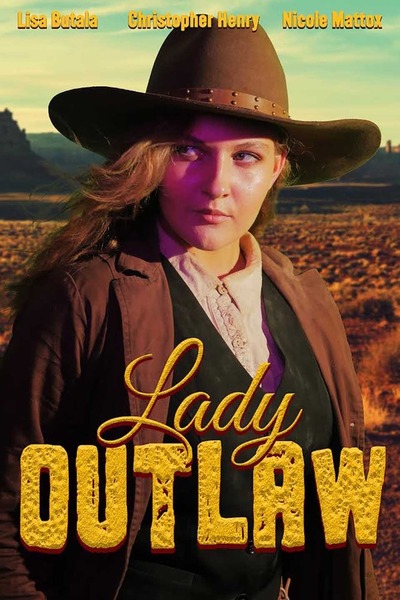 This low-budget Western does a lot of things right, but is not able to tie up all the loose ends in the final act. Most of which are ends that never needed to be loose in the first place. It takes place in 1890’s Oklahoma, when the gang of George ‘Bittercreek’ Newcomb (Henry) is trying to head back home. The gang includes a female outlaw, Rose Dunn (Butala), who is perhaps a little more moral than some members of the gang e.g. Tom, played by veteran villain Michael Ochotorena, this time covering up his impressive face tattoos. The situation comes to a head after Rose rescues a saloon girl, Ellie (Mattox), who just shot a man dead.
This low-budget Western does a lot of things right, but is not able to tie up all the loose ends in the final act. Most of which are ends that never needed to be loose in the first place. It takes place in 1890’s Oklahoma, when the gang of George ‘Bittercreek’ Newcomb (Henry) is trying to head back home. The gang includes a female outlaw, Rose Dunn (Butala), who is perhaps a little more moral than some members of the gang e.g. Tom, played by veteran villain Michael Ochotorena, this time covering up his impressive face tattoos. The situation comes to a head after Rose rescues a saloon girl, Ellie (Mattox), who just shot a man dead.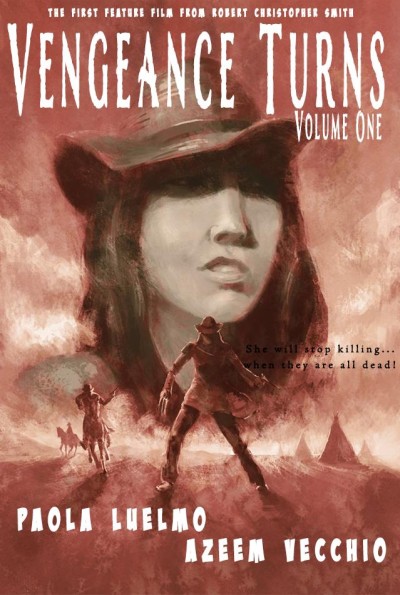 The film opens with a caption, “The first feature film from Robert Christopher Smith,” and it’s largely superfluous. Because, to be brutally honest, you can tell. It’s filled with choices which virtually scream, movie-making debut. That it’s a passion project for Smith is clear, and the persistence with which he pursued his vision is clear, and highly laudable. Perseverance can only take you so far, however, and is no substitute for skill and experience. It does feels this was a learning experience on the fly, with a palpable improvement over its course, and Smith left the production a significantly better film-maker than he came in, I suspect. At least it does tell a fairly complete story (glares over at
The film opens with a caption, “The first feature film from Robert Christopher Smith,” and it’s largely superfluous. Because, to be brutally honest, you can tell. It’s filled with choices which virtually scream, movie-making debut. That it’s a passion project for Smith is clear, and the persistence with which he pursued his vision is clear, and highly laudable. Perseverance can only take you so far, however, and is no substitute for skill and experience. It does feels this was a learning experience on the fly, with a palpable improvement over its course, and Smith left the production a significantly better film-maker than he came in, I suspect. At least it does tell a fairly complete story (glares over at 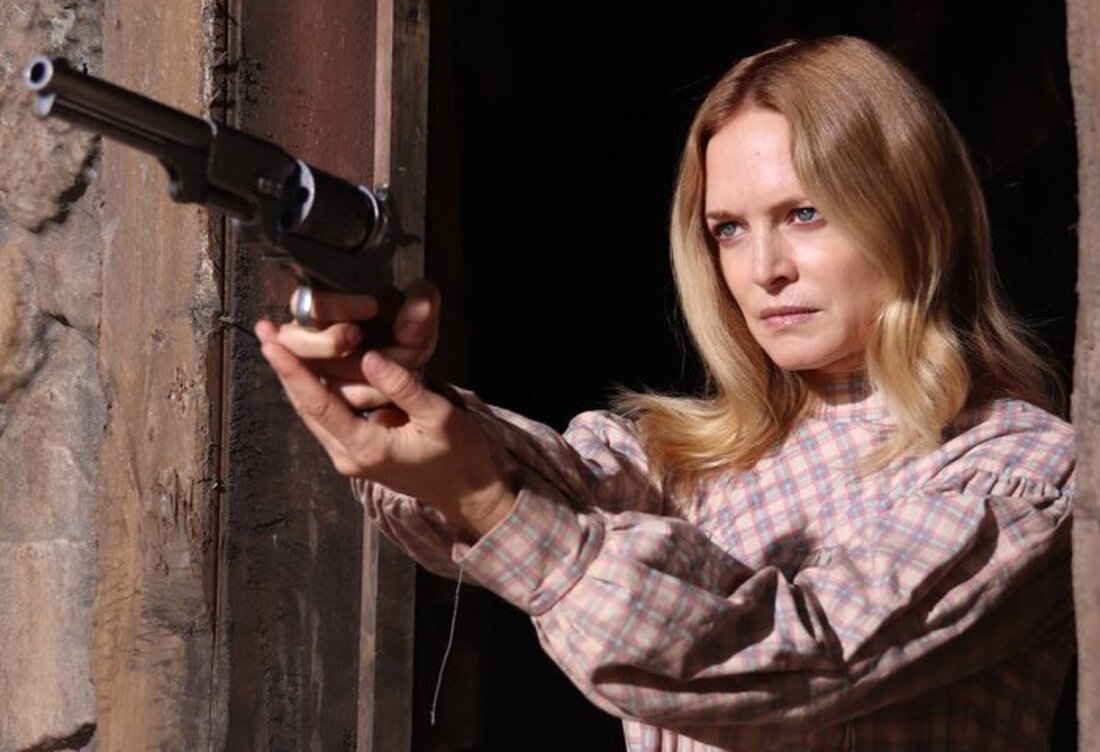 This is definitely a slow burn. The first hour is more concerned with depicting the life of Pandora and Hester, along with how Calhoun’s arrival changes things. Though I have to say, after how the film shifts at the end, you’ll find yourself viewing these early interactions in a very different light. Bear John doesn’t even arrive on screen until well into the movie, in a well-handled scene which does a good job of depicting his gang and their relationships. Thereafter, there’s a looming sense of threat, with a ticking clock of escalating tension as the cabin’s inhabitants try to get ready for the violence to come. Again, without revealing too much, mother and daughter may be more ready for this than they seem.
This is definitely a slow burn. The first hour is more concerned with depicting the life of Pandora and Hester, along with how Calhoun’s arrival changes things. Though I have to say, after how the film shifts at the end, you’ll find yourself viewing these early interactions in a very different light. Bear John doesn’t even arrive on screen until well into the movie, in a well-handled scene which does a good job of depicting his gang and their relationships. Thereafter, there’s a looming sense of threat, with a ticking clock of escalating tension as the cabin’s inhabitants try to get ready for the violence to come. Again, without revealing too much, mother and daughter may be more ready for this than they seem. However, there are definite flaws in Brandvold’s craftsmanship here, starting with chronology. John Bass served in the Mexican War, after which he married and settled in Kansas. The Bass family graveyard on the homestead is said to hold the remains of an infant sibling who died over 20 years before 1865 –in other words, before 1845, and the Bass twins would have been born ca. 1849. But the Mexican War was fought from 1846-1848. There isn’t time between Feb. 1848 and the end of 1849 to fit in John Bass’ post-war activity, subsequent courtship and marriage, the couple’s move to Kansas, and four pregnancies prior to Reno and Sara. (And Kansas was not even opened for settlement until 1854.) If his general knowledge of U.S. history didn’t furnish red flags here, very basic research would have precluded these kinds of mistakes.
However, there are definite flaws in Brandvold’s craftsmanship here, starting with chronology. John Bass served in the Mexican War, after which he married and settled in Kansas. The Bass family graveyard on the homestead is said to hold the remains of an infant sibling who died over 20 years before 1865 –in other words, before 1845, and the Bass twins would have been born ca. 1849. But the Mexican War was fought from 1846-1848. There isn’t time between Feb. 1848 and the end of 1849 to fit in John Bass’ post-war activity, subsequent courtship and marriage, the couple’s move to Kansas, and four pregnancies prior to Reno and Sara. (And Kansas was not even opened for settlement until 1854.) If his general knowledge of U.S. history didn’t furnish red flags here, very basic research would have precluded these kinds of mistakes. This is an interesting idea. Take a real-life historical action heroine, whose life provides the underlying framework, and write a fictional story around that. Obviously, Annie Oakley really existed, and the broad strokes of her life here are accurate. If you’ve read
This is an interesting idea. Take a real-life historical action heroine, whose life provides the underlying framework, and write a fictional story around that. Obviously, Annie Oakley really existed, and the broad strokes of her life here are accurate. If you’ve read 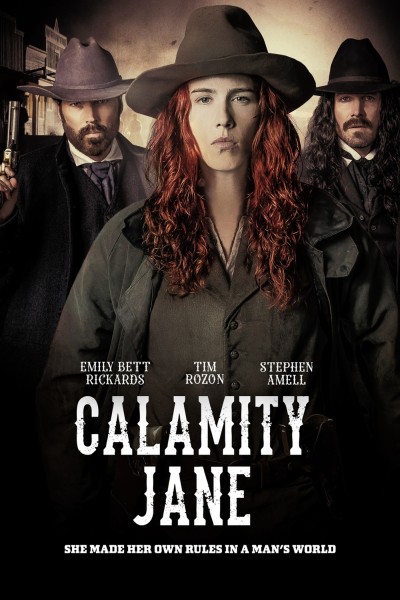 Calamity Jane and Wild Bill Hickok are two of the most well-known names in the culture of the Wild West, though the reality of both individuals is almost impossible to separate from the myths which surround them. So it’s kinda pointless to complain about historical accuracy in films which focus on them. Better just accept them as effectively being fictional entities, which can be used for whatever purpose a filmmaker desires. Here, it’s the death of Wild Bill (Stephen Amell, best known as TV’s Arrow) in a poker game, which sets his girlfriend Jane (Rickards, also from the same series) off. She goes on the trail of Jack McCall (Allon), the scumbag responsible, who has understandably opted to depart Deadwood.
Calamity Jane and Wild Bill Hickok are two of the most well-known names in the culture of the Wild West, though the reality of both individuals is almost impossible to separate from the myths which surround them. So it’s kinda pointless to complain about historical accuracy in films which focus on them. Better just accept them as effectively being fictional entities, which can be used for whatever purpose a filmmaker desires. Here, it’s the death of Wild Bill (Stephen Amell, best known as TV’s Arrow) in a poker game, which sets his girlfriend Jane (Rickards, also from the same series) off. She goes on the trail of Jack McCall (Allon), the scumbag responsible, who has understandably opted to depart Deadwood.  This documentary takes a look into the lives of three women in Texas, who are all operating in the male-dominated world of ranching. Some were born into it, while others came to it through choice. In particular, Mandy Dauses falls into the latter category, having left her East-coast home because she felt that Texas represented the best chance to fulfill her ambition of becoming a ranch manager. On the other hand, Sara Lemoine Knox is struggling to balance what she feels is an obligation to carry on in the family business, with her own goal of becoming a lawyer. Meanwhile, Martha Santos is looking to find work in that line, but without her own property, is finding it a challenge.
This documentary takes a look into the lives of three women in Texas, who are all operating in the male-dominated world of ranching. Some were born into it, while others came to it through choice. In particular, Mandy Dauses falls into the latter category, having left her East-coast home because she felt that Texas represented the best chance to fulfill her ambition of becoming a ranch manager. On the other hand, Sara Lemoine Knox is struggling to balance what she feels is an obligation to carry on in the family business, with her own goal of becoming a lawyer. Meanwhile, Martha Santos is looking to find work in that line, but without her own property, is finding it a challenge.